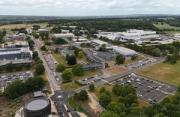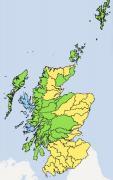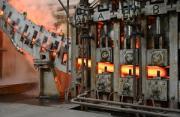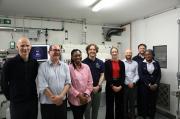Dounreay Announces Plans To Begin Seabed Clean-up Trials
22nd November 2006
UKAEA has announced plans to undertake trials of remotely operated technology that could be used to remove substantial numbers of particles from the seabed at Dounreay.
A notice placed in the Official Journal of the European Union seeks expressions of interest from companies capable of detecting and removing fragments of irradiated nuclear fuel known to be buried in the offshore sediment near the site's old effluent discharge outlet.
In recent years, divers have spent approximately 1500 hours mapping 500,000 square metres of seabed and recovered 929 particles in the process. Companies with feasible technology will be invited to demonstrate their capability off Dounreay next summer to see if the area of seabed where the largest and most hazardous particles are thought to reside could be remediated without the occupational risks associated with continued diving.
The announcement comes after a panel of experts, tasked with short-listing options for public consultation on the particles legacy, concluded that some form of particle retrieval from the seabed should feature in all the options.
Successful retrieval might reduce the number of particles that could be transported onto local beaches in future although it is recognised that disturbance of the seabed may lead to a short term increase in the numbers of particles that come ashore on the Dounreay foreshore and on the beach at Sandside. It was also recognised by the panel that recovery of every particle will not be practicable.
Dounreay's acting director Simon Middlemas said: "It has taken several years of painstaking research, �10 million of investment, valuable expert guidance from bodies such as the Dounreay Particles Advisory Group and important input and assistance from Sandside Estate to reach this milestone.
"I am pleased to announce that we will shortly begin testing particle retrieval systems in the sea off Dounreay, because clean-up of the seabed is an important feature of dealing with the environmental contamination that has arisen as a result of past practices on the Dounreay site."
UKAEA remains committed to improving the detection of particles arriving from the sea onto Sandside Beach, where 74 have been found, and the monitoring of local beaches in the vicinity of the clean-up.
Following an international tendering exercise and series of trials, four systems have been short-listed for the award of a new monitoring contract next year and the present Groundhog system is being upgraded through innovation in its electronics. Both developments are expected to result in increased particle detection capabilities on local beaches, subject to access.
Phil Cartwright, UKAEA's contaminated land and particles remediation project manager, said: "By working with the Scottish Environment Protection Agency, independent experts and the owner of Sandside, we have been able to improve our knowledge of the particles and have progressively increased our detection capabilities.
"The DPAG report published today has considered the significant monitoring data and the outcome of studies undertaken up to February 2006. It provides a comprehensive assessment of the particles issue based on the knowledge available.
"DPAG makes a number of important recommendations about further improvements, including increased monitoring coverage of the beach at Sandside to obtain more data about particle arrival rates, and I welcome this. We will now sit down with SEPA and the owner of Sandside to take these recommendations forward.
"The report makes a very important contribution to the process now underway to identify the Best Practicable Environmental Option and we will continue to provide information to DPAG as our knowledge increases."
Related Businesses
Related Articles
UKAEA develops 3D printing for fusion components
At its recently opened Central Support Facility (CSF), UKAEA has commissioned an electron beam additive manufacturing machine that can be used to incorporate tungsten into components, alongside a selective laser manufacturing machine. Fusion can play a key role in a global low carbon energy future.Advancing Fusion Remote Maintenance: Industry Collaboration Driving Innovation
As part of the Fusion Futures (FF) programme, UKAEA's Remote Applications in Challenging Environments (RACE) has partnered with industry leaders to develop two groundbreaking technologies for remote maintenance in fusion energy engineering. Thanks to FF funding, industry has taken the lead in maturing UKAEA technology concepts—delivering real-world solutions that enhance operational autonomy and reduce maintenance burdens in extreme environments.UKAEA launches International Fellowships Scheme for fusion
UKAEA has launched the International Fellowships Scheme, an initiative to help expand the global talent pool supporting the fusion industry. The scheme is part of the UKAEA's Fusion Opportunities in Skills, Training, Education and Research (FOSTER) Programme, which aims to train, support, and empower the next generation of professionals, who will help deliver fusion power to the grid.Kyoto Fusioneering and Astral Systems join Culham fusion hub
UKAEA's Culham Campus welcomes Kyoto Fusioneering and Astral Systems as its latest tenants. Two pioneering companies, Kyoto Fusioneering and Astral Systems, have joined the growing cluster of fusion technology and AI organisations at United Kingdom Atomic Energy Authority's (UKAEA) Culham Campus.
Water scarcity report from SEPA
The river catchments of the Nith, Dee (Galloway), Cree, Doon, Irvine and Ayr and the Clyde have been raised to Alert. The river catchments of the Shin, Naver, Conon, Spey, Deveron, Ythan, Don (Aberdeenshire), Dee (Aberdeenshire), Esk, Firth of Tay, Firth of Forth, Almond, Tyne (Lothian), Tweed, Esk (Dumfriesshire), Annan and Thurso remain at Alert.
Fusion-grade Steel Produced At Scale In UK-first
Researchers achieve 10x production cost savings for reduced activation steel. A United Kingdom Atomic Energy Authority (UKAEA) working group has successfully demonstrated the industrial scale production of fusion-grade steel.
UKAEA To Lead The Creation Of A Robotics And AI Cluster
UKAEA will lead the creation of a new £4.9m nuclear robotics and artificial intelligence cluster across Cumbria and Oxfordshire. The robotics and AI cluster was announced by UK Research and Innovation (UKRI) as one of seven new projects to kickstart economic growth and address regional needs: www.ukri.org The robotics and AI cluster will link Cumbria and Oxfordshire to accelerate the decommissioning of the UK's legacy nuclear fission facilities and keep people out of hazardous environments.
Diamonds Are Forever? World-first Carbon-14 Diamond Battery Made In Uk
The world's first carbon-14 diamond has been produced with the potential to provide power for thousands of years. Scientists and engineers from the UK Atomic Energy Authority (UKAEA) and the University of Bristol have successfully created the world's first carbon-14 diamond battery.
UKAEA Monthly Newsletter Latest Edition
Find out what has been happening at UKAEA in our monthly newsletter. Read about our recent activities and upcoming events.
UKAEA Newsletter - Edition 11 Published Today
Find out what has been happening at UKAEA in our monthly newsletter. Read about our recent activities and upcoming events.
